

Eysenck Personality Questionnaire. In psychology, Eysenck Personality Questionnaire (EPQ) is a questionnaire to assess the personality traits of a person.

It was devised by the psychologists Hans Jürgen Eysenck and his wife Sybil B. G. Eysenck.[1] Hans Eysenck's theory is based primarily on physiology and genetics. Although he was a behaviorist who considered learned habits of great importance, he considers personality differences as growing out of our genetic inheritance. Temperament is that aspect of our personalities that is genetically based, inborn, there from birth or even before. Dimensions[edit] Eysenck initially conceptualized personality as two, biologically-based independent dimensions of temperament measured on a continuum: Extraversion/Introversion: Extraversion is characterized by being outgoing, talkative, high on positive affect (feeling good), and in need of external stimulation.
Big Five personality traits. In psychology, the Big Five personality traits are five broad domains or dimensions of personality that are used to describe human personality.

The theory based on the Big Five factors is called the five-factor model (FFM).[1] The five factors are openness, conscientiousness, extraversion, agreeableness, and neuroticism. Acronyms commonly used to refer to the five traits collectively are OCEAN, NEOAC, or CANOE. Beneath each global factor, a cluster of correlated and more specific primary factors are found; for example, extraversion includes such related qualities as gregariousness, assertiveness, excitement seeking, warmth, activity, and positive emotions.[2]:24 The Big Five model is able to account for different traits in personality without overlapping. Empirical research has shown that the Big Five personality traits show consistency in interviews, self-descriptions and observations. §Five factors[edit] Openness to experience: (inventive/curious vs. consistent/cautious). Carl Jung. Carl Gustav Jung (/jʊŋ/; German: [ˈkarl ˈɡʊstaf jʊŋ]; 26 July 1875 – 6 June 1961), often referred to as C.

G. Jung, was a Swiss psychiatrist and psychotherapist who founded analytical psychology.[2] Personal unconscious. In analytical psychology, the personal unconscious is Carl Jung's term for the Freudian with the collective unconscious.
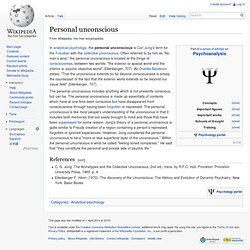
Often referred to by him as "No man’s land," the personal unconscious is located at the fringe of consciousness, between two worlds: "the exterior or spacial world and the interior or psychic objective world" (Ellenberger, 707). As Charles Baudouin states, "That the unconscious extends so far beyond consciousness is simply the counterpart of the fact that the exterior world extends so far beyond our visual field" (Ellenberger, 707). The personal unconscious includes anything which is not presently conscious, but can be. The personal unconscious is made up essentially of contents which have at one time been conscious but have disappeared from consciousness through having been forgotten or repressed. C. Collective unconscious. Collective unconscious is a term of analytical psychology, coined by Carl Jung.
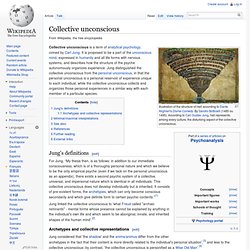
It is proposed to be a part of the unconscious mind, expressed in humanity and all life forms with nervous systems, and describes how the structure of the psyche autonomously organizes experience. Jung distinguished the collective unconscious from the personal unconscious, in that the personal unconscious is a personal reservoir of experience unique to each individual, while the collective unconscious collects and organizes those personal experiences in a similar way with each member of a particular species. Jung's definitions[edit] Psychodynamics. Psychodynamics, also known as dynamic psychology, in its broadest sense, is an approach to psychology that emphasises systematic study of the psychological forces that underlie human behavior, feelings, and emotions and how they might relate to early experience.
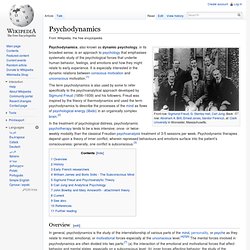
It is especially interested in the dynamic relations between conscious motivation and unconscious motivation.[1] The term psychodynamics is also used by some to refer specifically to the psychoanalytical approach developed by Sigmund Freud (1856–1939) and his followers. Freud was inspired by the theory of thermodynamics and used the term psychodynamics to describe the processes of the mind as flows of psychological energy (libido) in an organically complex brain.[2] In the treatment of psychological distress, psychodynamic psychotherapy tends to be a less intensive, once- or twice-weekly modality than the classical Freudian psychoanalysis treatment of 3-5 sessions per week. Overview[edit] History[edit] Current[edit] Sigmund Freud. Sigmund Freud (/frɔɪd/;[2] German pronunciation: [ˈziːkmʊnt ˈfʁɔʏ̯t]; born Sigismund Schlomo Freud; 6 May 1856 – 23 September 1939) was an Austrian neurologist, now known as the father of psychoanalysis.

Psychoanalysis. Psychoanalysis is a set of psychological and psychotherapeutic theories and associated techniques, originally popularized by Austrian physician Sigmund Freud and stemming partly from the clinical work of Josef Breuer and others.
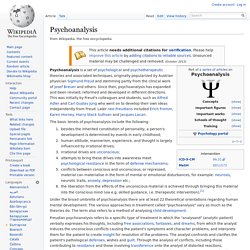
Since then, psychoanalysis has expanded and been revised, reformed and developed in different directions. This was initially by Freud's colleagues and students, such as Alfred Adler and Carl Gustav Jung who went on to develop their own ideas independently from Freud. Later neo-Freudians included Erich Fromm, Karen Horney, Harry Stack Sullivan and Jacques Lacan. Dream interpretation. Dream Interpretation is the process of assigning meaning to dreams.

In many ancient societies, such as those of Egypt and Greece, dreaming was considered a supernatural communication or a means of divine intervention, whose message could be unravelled by people with certain powers. In modern times, various schools of psychology and neurobiology have offered theories about the meaning and purpose of dreams. Early history[edit] Eastern Mediterranean[edit] One of the earliest written examples of dream interpretation comes from the Babylonian Epic of Gilgamesh.[1][2] Gilgamesh dreamt that an axe fell from the sky.
In ancient Egypt, priests acted as dream interpreters. In medieval Islamic psychology, certain hadiths indicate that dreams consist of three parts, and early Muslim scholars recognized three kinds of dreams: false, patho-genetic, and true.[6] Ibn Sirin (654–728) was renowned for his Ta'bir al-Ru'ya and Muntakhab al-Kalam fi Tabir al-Ahlam, a book on dreams. Fantasy (psychology) Fantasy in a psychological sense is broadly used to cover two different senses, conscious and unconscious.
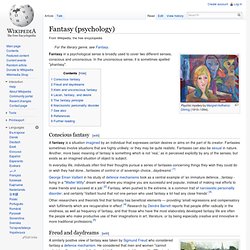
In the unconscious sense, it is sometimes spelled "phantasy". A fantasy is a situation imagined by an individual that expresses certain desires or aims on the part of its creator. Fantasies sometimes involve situations that are highly unlikely; or they may be quite realistic. Fantasies can also be sexual in nature.
Another, more basic meaning of fantasy is something which is not 'real,' as in perceived explicitly by any of the senses, but exists as an imagined situation of object to subject. In everyday life, individuals often find their thoughts pursue a series of fantasies concerning things they wish they could do or wish they had done...fantasies of control or of sovereign choice...daydreams'.[1] A similarly positive view of fantasy was taken by Sigmund Freud who considered fantasy a defence mechanism. Daydreams for Freud were thus a valuable resource.
Jump up ^ Erik H. Free association (psychology) Free association is a technique used in psychoanalysis (and also in psychodynamic theory) which was originally devised by Sigmund Freud out of the hypnotic method of his mentor and coworker, Josef Breuer. 'The importance of free association is that the patients spoke for themselves, rather than repeating the ideas of the analyst; they work through their own material, rather than parroting another's suggestions'.[1] James Strachey (1887-1967) considered free association as 'the first instrument for the scientific examination of the human mind'.[2] "There can be no exact date for the discovery of the 'free association' method... it evolved very gradually between 1892 and 1895, becoming steadily refined and purified from the adjuvants - hypnosis, suggestion, pressing, and questioning - that accompanied it at its inception".[4] Freud called free association "this fundamental technical rule of analysis...
Free association is contrasted with Freud's "Fundamental Rule" of psychoanalysis. Ego. It may also refer to: Id, ego and super-ego. Although the model is structural and makes reference to an apparatus, the id, ego and super-ego are purely symbolic concepts about the mind and do not correspond to actual somatic structures of the brain (such as the kind dealt with by neuroscience). The concepts themselves arose at a late stage in the development of Freud's thought: the "structural model" (which succeeded his "economic model" and "topographical model") was first discussed in his 1920 essay Beyond the Pleasure Principle and was formalized and elaborated upon three years later in his The Ego and the Id.
The Ego and the Id. Overview[edit] The Ego and the Id develops a line of reasoning as a groundwork for explaining various (or perhaps all) psychological conditions, pathological and non-pathological alike.